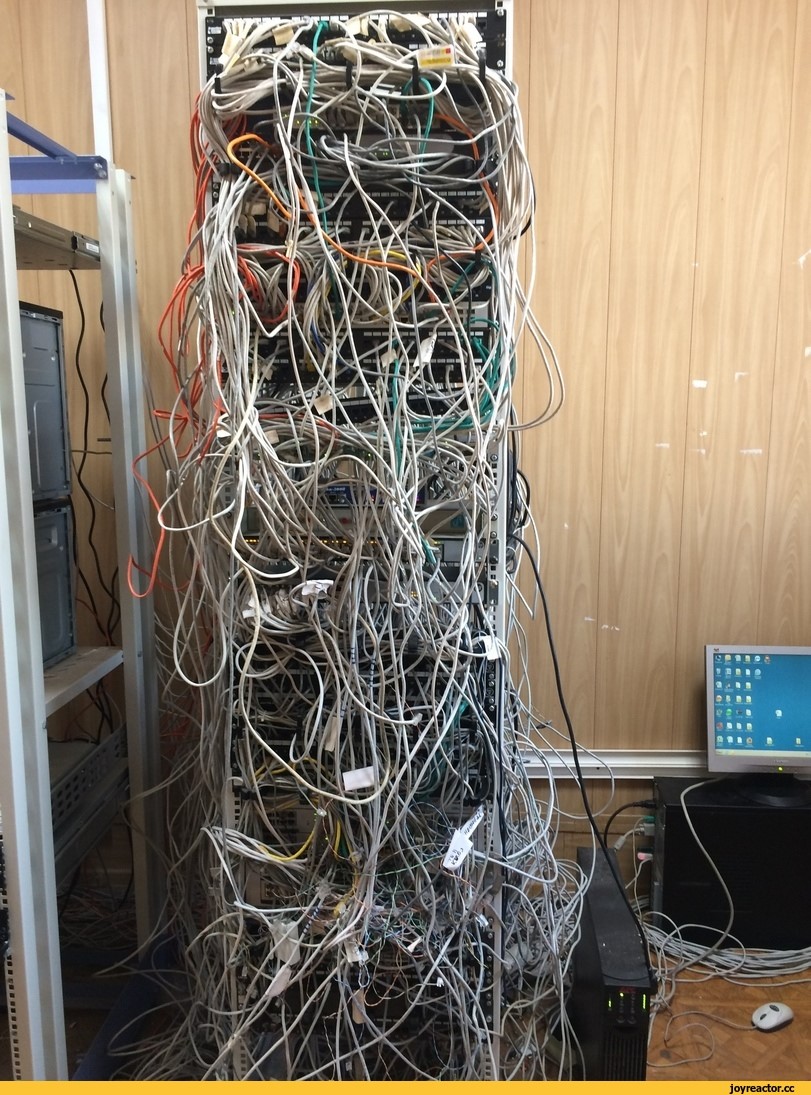
Source: Yandex.Kartinki
Despite the massive migration of business to the clouds, there are still companies whose management follows the strategy of “I carry everything with me”, for various reasons not entrusting their computing power to third-party data centers. However, setting up your own server room is not as easy as many decision makers believe. In this post we will tell you about the mistakes that are made when designing and implementing a server room yourself.
Paradoxically, errors in the design of server rooms are made not only by small companies, but also by large organizations. The reason is ridiculously simple: the desire to save IT budget, especially when it comes to equipping regional divisions. As a result, instead of a server room, rather original structures are obtained, even remotely unlike a place where you can safely place expensive equipment that ensures the work of all employees.
The three main components of a reliable server room are the right room, a quality climate control system and a reliable power supply. Let's consider what mistakes are encountered in the design and implementation of these components, what consequences they lead to, and how to avoid them.
Room selection errors
1. Close proximity to water and other liquids
If there is a basement in the building of the organization, then with a high probability it will be offered to use it for the server room equipment. This seems to be the best solution in all respects:
- basement rental costs less than full-fledged office space,
- the noise of the equipment will not disturb anyone,
- IT employees will not disturb the decorous atmosphere of the office and scare away clients with scattered pieces of iron and frayed wrinkled T-shirts.
However, it is in the basement that the water pipes and sewer pipes pass. And if an accident happens on the upper floors, it is in the basement that water will flow from a burst battery or a block of the central air conditioning system.
:
, . , , , . 50 . , «» . , , .
, , .
Hence the recommendation # 1 : choose only dry rooms for server rooms, into which water and / or other liquids cannot penetrate.
2. Ignore floor loads
Depending on the equipment being placed, a fully loaded 42U rack or cabinet can weigh up to 1000 kg. If there are several such cabinets, the load on the floor may exceed the maximum allowable. This parameter is especially critical for old buildings, the strength of the floors in which may turn out to be significantly lower than required for the safe placement of equipment.
Recommendation # 2 : Before approving a server room, check the weight of the equipment and the strength of the floors.
3. Choosing a room of "original" form
When choosing a room for server rooms, the following factors should be considered
- the number and depth of racks available,
- the prospect of expanding the company and increasing the number of equipment,
- the need for front and rear access to the racks for maintenance,
- the need for sufficient space for air circulation.
If you ignore these factors, you might find that IT staff can't access racks, new hardware has nowhere to install, and patch panel cabling has become a sysadmin's hell.
:
-, , , , . . , . 50 , , :

, , , — . : AliaDen / reactor.cc
Another similar incident occurred in another branch of the same bank. The IT department was asked for the area of the server rack and the number of those racks. As a result, instead of a normal server room, there was a "gut" width in the depth of the rack plus 90 cm so that a person could pass. In this form, the server room existed for about two years, until an internal audit came to the branch and issued a formidable prescription.
And here is the recommendation number 3 : when determining the area of the server room, place racks and other equipment on the plan, taking into account future expansion, and do not agree to compromises with the management, especially when it comes to "original" design solutions.
Errors in the air conditioning and ventilation system
1. Use of household air conditioners
Many managers sincerely believe that to cool the server room it would be quite appropriate to put a household air conditioner in it - the main thing is to choose a model of a well-known manufacturer, and for reliability, put not one "head", but two, to turn them on in turn, come on them "to rest".
However, household split systems are not designed to operate in a 24 × 7 × 365 mode, therefore, after a relatively short time, they may fail. In addition, they cannot direct the cold air flow to the “hot” area, which greatly reduces the cooling efficiency.
Another problem with household air conditioners is the inability to connect them to a temperature monitoring system. This excludes the possibility of controlling the microclimate in the server room in accordance with the specified parameters.
:
, , . , «» . : , «». .
Recommendation # 4 : Never try to save money on the server room by using household air conditioners. Even if management insists, do your best to prevent such a decision.
2. Using a centralized ventilation system to cool the server room
Another "ingenious" solution is an attempt to use a centralized air conditioning system to cool the server room. Such a solution has even less right to exist, since the cooling in it works only at a limited temperature range, and at night the cooling system is turned off to save electricity, so it will not be possible to cool the air in the server room at this time.
:
, . , . , «» . . . , , , , .
№ 5 , -: .
1. Use of simple UPSs in all parts of the infrastructure
The desire to save money leads to the fact that some companies buy a large batch of inexpensive UPSs with a capacity of 500-1000 VA and use them not only in workplaces, but also for server racks. Managing such an army of uninterruptible power supplies is extremely difficult, especially with a large number of jobs. It is also impossible to ensure the reliable operation of such UPSs, especially when power surges are frequent.
:
: 500 ·, «» 1000 ·. , , «» . , . , , , , . , .
Recommendation # 6 : you cannot use cheap backup UPSs in server rooms - server failures, downtime and data loss will cost much more than such "savings"
2. Insufficient UPS power rating
When overloaded, the UPS switches to the internal static bypass (bypass line), so the load becomes unprotected both from the poor quality of the input power supply, and from the loss of this very input power supply - which creates additional risks of data loss or failure of infrastructure components.
Recommendation # 7 : For the UPS to operate the connected equipment, the maximum load on it should not exceed 80% of the rating. This means that it is recommended to load a UPS with a rated power of 50 kVA no more than 40 kVA.
Single-phase line-interactive devices can be placed in racks, but for a centralized system, you have to choose between three-phase solutions with double conversion of electricity. This option is more reliable, but more expensive.
3. Wrong choice of an uninterruptible power supply scheme
At the design stage of the server room, it is necessary to decide how the uninterrupted power supply will be organized. If this issue is not addressed in advance, fixing errors can lead to significant costs and downtime.
Recommendation No. 8 will be somewhat more extensive than the previous ones. Most often, there are three options for organizing an uninterruptible power supply:
- ;
- ( );
- , .
The distributed scheme is more difficult to manage and does not allow efficient use of the power of individual UPSs. Redundancy in it is usually implemented according to the 2N scheme - two UPSs per rack.
Higher initial costs of modularity are only worthwhile in redundant configurations. It all depends on individual needs.

The Eaton product line includes specialized UPSs that effectively solve the problem of organizing uninterruptible power supply of server equipment for medium and small businesses: the Eaton 5PX model is a 2200 VA line-interactive UPS with an efficiency of up to 99%, designed to protect servers and network equipment, storage systems and VoIP. Photo: Eaton
We turn uniqueness into unification
Each server room has its own unique history, despite the desire of integrators and designers to implement unified projects. We have analyzed the common design mistakes of server rooms and provided recommendations to avoid unpleasant consequences.
For those who are interested, we will tell you in the end how the story with the bank's branch ended. The branch moved to another building and was located on three floors. A spacious server room with an automatic climate control system is located on the second floor. A separate room was allocated next to the server room for a centralized modular UPS, and a diesel generator set was installed in the basement with automatic start in case of a power outage. Not to say that everything was done perfectly, but five years of torment with an incorrectly designed server room taught a lot both to management and employees. The old branch office was taken over by another bank. We were unable to find out how he disposed of the semicircular room.